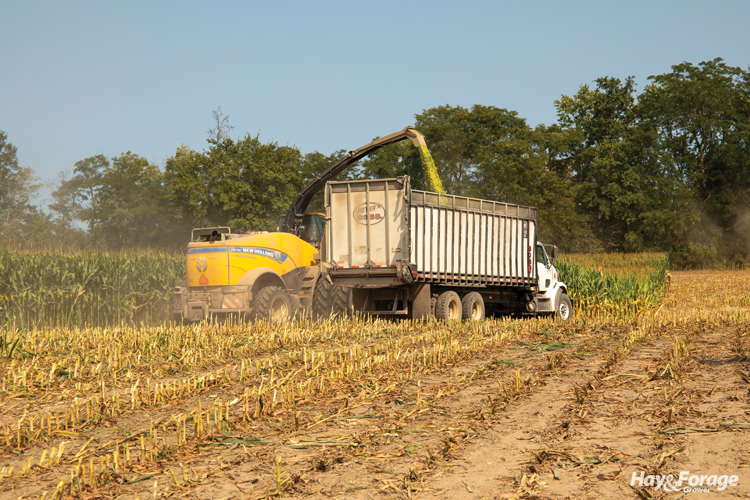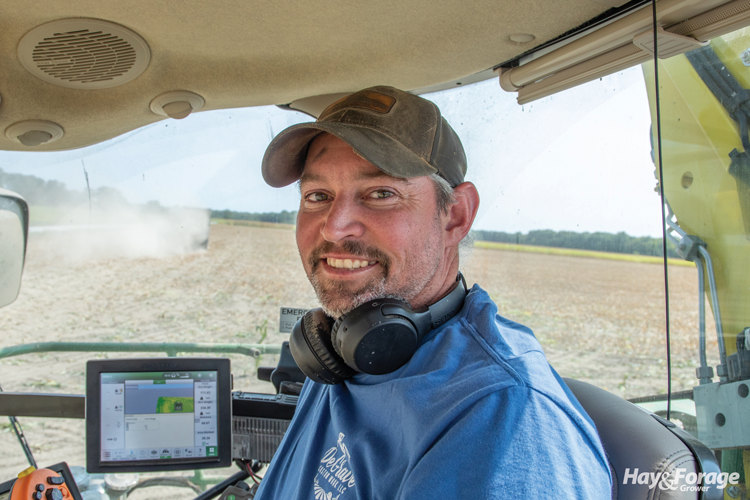
It would be reasonable to surmise the largest dairy county in Illinois might be situated on the state’s northern Wisconsin border. Such was the case 10 years ago, but these days, you’ll find the most Land of Lincoln dairy farms in Clinton County, which is located about 270 miles south of Wisconsin and just east of the St. Louis metro area.
One of the 50 or so Clinton County dairy farms is operated by Bryan Henrichs and his brother Rodney. Their grandfather started the dairy in 1938 after his father bought each of his sons their own farm. Bryan and Rodney’s father, who passed away last year, took over the dairy in the mid-1960s and expanded the herd. Currently, the farm milks 300 cows with mostly family labor and a plan to further expand in the next few years.
In addition to his daily dairy duties, Bryan Henrichs is the majority owner of a unique five-chopper custom forage harvesting business that originally grew out of their dairy’s farming operation.
“In the mid-1990s, we had one of the first 15-foot no-till drills, and some of the neighbors were asking us to custom-plant their soybeans after a wheat harvest,” Henrichs explained of how his custom business started. “That seeding business grew, and a few of our customers also asked us to help them chop corn silage. Of course, back then, we only had a pull-type chopper. The requests just kept coming, so around 2000 we bought a new New Holland FX28 self-propelled chopper from a nearby dealer. Dad told me to learn everything I could about that machine so we wouldn’t have to pay someone to come out and fix every little thing. He also assigned me to running the chopper,” he added.
With the new chopper, Henrichs picked up a lot more acres, including opening up fields for other farms that had pull-type machines. Henrichs continued, “We kept getting more requests to chop, and in 2006, we traded that chopper in for an FX40. A couple of years later we had the remnants of a hurricane come through the area and flatten all of the corn. Our six-row head was the only unit in the area that was able to pick up the corn, and we ended up chopping everybody’s corn in 2008. All of that dirt we picked up getting the lodged corn harvested wore out that chopper, so we traded it in for an FX50.”
Over time, the custom work had become so time consuming that the Henrichs’s own forage wasn’t getting harvested in a timely manner. So, in 2010, Henrichs bought his own equipment and started a separate custom harvesting business. “I bought a new chopper that came from a dealer in Eden, Wis.,” Henrichs said. “Business kept growing, and then in 2012, we had a severe drought. There was a lot of ‘zeroed-out’ corn in the area, and the local dairies were buying up corn from the grain farmers to chop. With my six-row head, I ended up chopping about 4,000 acres of corn that year.”
A new business model
It was another crop disaster that brought about a significant and beneficial change to Henrichs’s custom harvesting business.
In 2013, he bought a new FR-model chopper. Three years later, a southern rust outbreak hit the area and the corn seemingly died within days. “By then, I had two choppers plus our farm’s chopper, so we were able to cover a lot of acres that year,” Henrichs recalled. “We also ended up helping another custom harvester, Tyler Henry, in southern Illinois because they were behind. Through helping him that year, we ended up forming a partnership. This allowed us both to save money on equipment, and it worked well because his customers had corn ready to chop before ours did.”

Henry, based in Red Bud, Ill., also has a large grain farm and chops silage as a side business. His customer base stretches down the I-55 corridor into Missouri. Currently, Midwest Custom Chopping, as the partnership is now known, goes as far south as Cape Girardeau, Mo., and as far north as Nokomis, Ill. This year, the chopping business also harvested industrial hemp near Sikeston, Mo.
Henry does a lot of the billing and paperwork for the business. This is usually accomplished in the morning before he starts combining corn or soybeans. An accounting program is used that breaks down all of the annual costs.
These days, Midwest Custom Chopping has about 75 clients, with 75% of them being dairy farms and beef operations making up the remainder. Most of the dairies are 200 to 300 cows with the largest client milking 800 cows. Henrichs’s customer base is pretty consistent from year to year. “If we wanted to grow anymore, we’d have to go farther out of the region,” he asserted. “I want to stay reasonably close to our dairy, so that’s where having partners has helped. Even so, I will help out down South, and I usually harvest for Purina’s farm in Gray Summit, Mo., which is about an hour-and-15-minute drive. I have to skip out of milking a little early on those days.”
The partnership runs four New Holland choppers and one John Deere. Only corn silage, wheat, and some first-cut alfalfa (300 to 400 acres) is harvested. Most of the subsequent alfalfa cuttings in the area are baled. Annually, about 7,000 to 8,000 acres of corn silage is chopped in Missouri and Illinois by the partnership. One chopper is permanently set up for alfalfa, even during the corn silage season, just in case a request is made to chop a fall cutting. The silage choppers are all equipped with Scherer kernel conditioning rolls. Henrichs said they also harvest about 400 to 500 acres of earlage each fall. Trucking forage is hired from a third party, and they also hire trucking to move equipment if the job is more than an hour drive away.
In addition to chopping corn and alfalfa, Henrichs does some custom planting, baling (4,000 bales of hay and straw), and combining with his own farm’s equipment. This helps make owning the equipment more cost effective for the dairy operation.
Midwest Custom Chopping buys all of their equipment. Choppers are traded in depending on their operating hours and how trouble-free a machine has been. Henrichs said that they do a lot of the maintenance and repair work themselves and keep an extensive parts inventory, especially for those items that have a history of wearing or breaking.

Another partner
Several years after forming a partnership with Henry, the duo was approached by Gary Arentsen, who has a silage-bagging business as a part of his local farm supply and equipment business. He wanted to become involved in the partnership so he could have a chopper at his disposal when his bagging customers needed to harvest. Arentsen rents out seven baggers in the area and has 15 employees.
“We were having trouble keeping our large dump bagger married to a chopper,” Arentsen explained. “So, about four years ago, we bought into the chopping business to ensure there would be a harvester to run with the bagger, if it’s needed.”
Now, as the Midwest Custom Chopping partnership is currently set up, Henrichs remains the majority owner at 50%. Henry and his farm operation, Marigold Farms, owns 25%, and Arentsen owns 25%.
Machine sharing
As it turned out, Arentsen wouldn’t be the last person to be involved with Midwest Custom Chopping. Henrichs said in 2015 they had bought some Capello direct-cut heads for their choppers. He explained, “We were harvesting a lot of mature wheat that was being cut after heading; it was being fed to dry cows and heifers. If it was cut and left to lie in a windrow, it would get too dry and the grain loss was substantial. The direct-cut heads allowed us to minimize those losses and get the crop in at the correct dry matter. Ideally, we like to harvest it at about 60% moisture. Now, a lot of beef farms are using it as a roughage source. Currently, we chop 1,200 to 1,500 acres of direct-cut wheat with two heads.”

Henrichs continued, “I got into a Facebook discussion with Willie DeGrave, a northeast Wisconsin custom chopper who was interested in using a direct-cut head for cereal rye. He ended up renting one of our heads because their season was about a month later than ours. That led to sharing more equipment. In 2019, we had a wet spring and a narrow planting window. All of the crop was ready to chop at the same time, so I had DeGrave come down with his crew and help harvest. After that, we kept working together, and last year we purchased a John Deere 9900 chopper together, which is used at both locations every year but only for corn silage. Moving forward, I could see us sharing another forage harvester together; it just makes economic sense.”
DeGrave, who harvests nearly 20,000 acres of alfalfa and over 6,000 acres of corn silage in the Badger State, also sees benefits to the arrangement. “It’s really been working out well with this first chopper,” he said. “These new forage harvesters are over a million dollars, and it’s hard to justify that amount of money unless you can put 500 hours on them in a year. Brian usually gets done with corn about a week or two before we start. I can definitely see us purchasing another chopper together. The important thing with this type of arrangement is that you have to have a good friendship and be trusting of the person you’re working with. Brian and I have that.”
Economic efficiency wasn’t the only advantage Henrichs cited for sharing high-priced equipment with DeGrave. He noted that there isn’t much of a market for used choppers in southern Illinois, so his local dealer struggles on selling the trade-ins.
“Our partnership with Willie enables us to utilize the Wisconsin market where there’s more demand.” Henrichs said. “We still use a local dealer for our New Holland choppers, but our mechanic, who comes down every spring to go over the equipment, is based in Wisconsin. In this business you have to network with people who know the equipment. Our John Deere mechanic is in Wisconsin, too.”

Moving forward
Even though the custom chopping business has become a major enterprise, Henrichs remains committed to staying involved in the dairy business. He still helps milk cows every day and serves as vice president on the board of directors for Prairie Farms milk cooperative, chairing their strategic planning committee. Henrichs also serves on the board for the Illinois Milk Producers Association and the American Dairy Coalition, which is based in Wisconsin and focuses on federal dairy policy. In recent years, he has committed himself to learning about our complex milk pricing system and has testified at the Federal Milk Marketing Order hearings to help bring about needed changes to pricing policy.
Henrichs’s cows, although important, aren’t the most cherished females in his life. He and his wife, Emily, who works at the Children’s Hospital in St. Louis as a dialysis nurse, have five daughters, ages 8 to 16 years old.
As Henrichs looks to the future for his custom chopping business, he said the long game is to provide a cost-competitive service by continuing to have partners and associates from other regions. “Locally, there’s not much opportunity for our business to grow in this area, but there are always ways to cut costs and become more efficient,” the entrepreneur asserted.
This article appeared in the November 2024 issue of Hay & Forage Grower on pages 6-9.
Not a subscriber? Click to get the print magazine.

